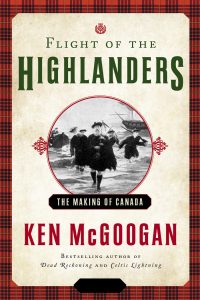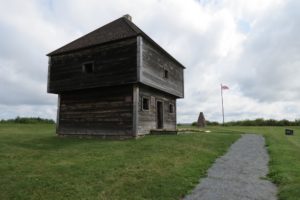Flora MacDonald sojourns in Nova Scotia
[Nice to see a new biography of Jacobite heroine Flora MacDonald hitting the bookstores. Wonder if it will have anything to say about her sojourn in Nova Scotia. Here we have a few paragraphs that, in the final version of Flight of the Highlanders, I expanded considerably.]
We drove sixty-five kilometres north out of Halifax, Sheena and I, to visit Fort Edward, now a National Historic Site. Situated in Windsor on a hill overlooking Minas Basin, it speaks to the truth that the Highland Clearances did not always produce a simple, straightforward narrative featuring a single departure and one resettlement – say for the people of the Hector. For many, the flight to the northern colonies that evolved into Canada required two departures – one from Scotland and another from the United States. For some, “the dance called America” proved more complicated still – and left them undertaking a third departure.
Consider Jacobite heroine Flora MacDonald, who spent time at Fort Edward during the American Revolution. She left Scotland in response to the Clearances, but in the end failed to qualify for inclusion in this book. In 1774, she and her husband emigrated to North Carolina and bought a farm. But then came the Revolution. Flora’s husband, Allan MacDonald, led an ill-prepared Loyalist force into an ambush at Moore’s Creek Bridge. He was captured and remained a prisoner for roughly two years. Eventually, he negotiated his release. Then he took command of the Royal Highland Emigrants at Fort Edward.
At that time, as we learned during our visit, a four-cornered wooden palisade enclosed numerous buildings: barracks, officers’ quarters, a bakery, kitchens, stores, a two-storey wooden blockhouse. The blockhouse, now a museum, is all that remains standing. But that was enough, as we stood out front in the wind, to fire the imagination with the journey that had brought Flora MacDonald to this isolated outpost.
Late in the autumn of 1778, after spending two harrowing years on the run, she sailed north out of New York to join her husband. By the time she reached Halifax, she wrote later, she “was very nigh death’s door by a violent disorder the rough sea and long passage had brought on.” Flora stayed in Halifax for eight days “on account of my tender state.” On the ninth day, she set out for Fort Edward, travelling through woods and snow by horse-drawn sleigh. On day five she reached the Fort, where even the officers’ quarters were cramped, spartan, and miserable. “There we continued all winter and spring,” she wrote later of her Nova Scotia sojourn, “covered with frost and snow, and almost starved with cold to death, it being one of the worst winters ever seen there.”
In mid-January Flora lost the only congenial female company she had found when another officer’s wife died in childbirth. She turned fifty-seven and as the year wore on, she began to dread the thought of enduring another winter at Fort Edward, and to think wistfully of her old life on Skye. In October, with war still raging to the south, and her husband obliged to remain where he was, Flora sailed back across the Atlantic. Her husband joined her after the war and she ended her days in relative comfort on the Isle of Skye.

What an ordeal! And her poor friend! Women had it so tough in those days, it sounds trite even to say so. Thanks for another enjoyable history lesson, Ken.